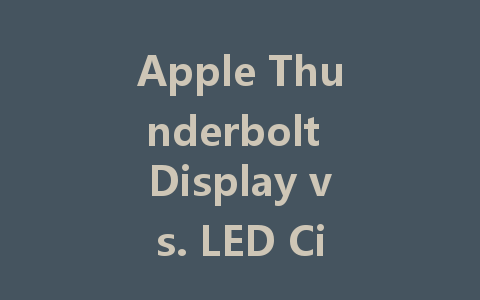
When it comes to professional-grade monitors, Apple’s offerings have long been synonymous with quality and performance. Two of the most talked-about displays are the Apple Thunderbolt Display and the LED Cinema Display. But how do these two giants stack up against each other? In this article, we’ll dive into a comprehensive comparison to help you decide which display is best suited for your needs.
Understanding the Displays: Key Features
Apple Thunderbolt Display
The Apple Thunderbolt Display, introduced in 2011, was a game-changer in the world of monitors. Here are some of its standout features:
LED Cinema Display
On the other hand, the LED Cinema Display—a predecessor to the Thunderbolt series—was released in
Performance: Speed and Efficiency
Thunderbolt Technology
One of the significant advantages of the Thunderbolt Display is its use of Thunderbolt technology, which allows for faster data transfer rates of up to 10 Gbps. This speed is crucial for professional users dealing with large files, such as graphic designers or video editors, as it significantly enhances workflow efficiency.
Standard USB Connectivity
In contrast, the LED Cinema Display’s reliance on USB 2.0 means it is slower in data transfer rates, which can be a bottleneck for those who require high-speed connectivity. For everyday tasks, it may still perform well, but for high-demand applications, the Thunderbolt Display is clearly the superior option.
Design and Usability
Aesthetic Appeal
Both displays sport a sleek, modern design that complements Apple’s aesthetic. The Thunderbolt Display, however, is slightly more refined, with thinner bezels and a more premium feel.
Ergonomics and Adjustability
When it comes to usability, both monitors have adjustable stands, but the Thunderbolt Display provides more flexibility in height adjustment and rotation. This enhances user comfort during prolonged use, making it ideal for professionals who spend hours in front of their computers.
Compatibility and Future-Proofing
System Compatibility
The Thunderbolt Display is compatible with a broader range of newer Apple devices due to its Thunderbolt connection. This means it can work seamlessly with the latest Macs, MacBooks, and even some iPads.
Conversely, while the LED Cinema Display can still connect to many Apple devices, it may not support all the advanced features available with newer hardware, limiting its future-proofing.
Longevity
Given the direction in which technology is headed, investing in a Thunderbolt Display may be more pragmatic for users intending to keep their monitor for years to come. Its advanced connectivity options mean it is less likely to become obsolete quickly compared to the LED Cinema Display.
Conclusion: Making the Right Choice
Choosing between the Apple Thunderbolt Display and the LED Cinema Display ultimately depends on your specific needs. If you’re leaning towards high-speed data transfer, enhanced connectivity, and a future-proof investment, the Thunderbolt Display is the clear winner.
On the other hand, if you are looking for a more budget-friendly option and don’t require the speed advantages of Thunderbolt technology, the LED Cinema Display may still serve you well for general use.
Whichever display you choose, both options provide exceptional quality that Apple is known for. Consider your workflow requirements and compatibility needs before making a decision, and you’ll be sure to select the right display for your setup.